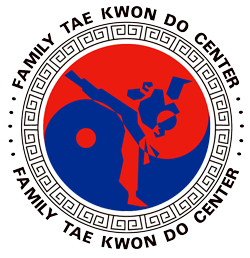Wonshim
The three circles represent Mind, Heart, Body; together in the universe
The man in action represents Taekwondo and Justice
The red background represents the Sun (discipline)
The yellow border represents Seeds (student)
The blue border represents Water (humility)
The Chinese lettering represents Wonshim training mind, heart and body to become an action philosopher
Theory of Wonshim Movement and Techniques
The name Wonshim derives from two Korean words: Won meaning circle or perfection; and Shim meaning heart or inner strength. The combination of these two words and their meanings embody the most important aspects of Wonshim study.
From the earliest times, the theory of the circle has been a predominant thought of everyday life in Korea and Japan. The Taekwondo ranking system utilizes the circle theory. A student starts as a white belt, knowing very little about the martial arts, and moves through the darkening belts before becoming a black belt. When the student achieves the black belt, he begins a new journey. So, too, in life; each goal we reach marks a new beginning.
The theory of the circle is emphasized in another way in Taekwondo training. Every man has his own circle, and inside this circle is his private territory. If someone were to enter this private domain without approval or proper warning, each man has the right to defend against this invasion. In actual practice, when an opponent punches, if this punch does not trespass into one's circle, there is no need to block. If one chooses to block, it is considered a waste of time and energy.
When an opponent's punch or kick does penetrate the circle, it should be received indirectly. Leading this force in a circle minimizes its effect. Utilizing a circle or winding block not only disrupts an opponent's force, but also sets the position for a counterattack. Furthermore, countering with techniques that are directed at an opponent along a straight line and then returned along the same line will prove to be less effective.
The circle is the essence of the strategy and movement in Taekwondo. The infinite points on a circle represent the unlimited positions we move to and counter from in meeting an opponent.
Circular movements mean that rather than meeting an opponent head-on, you should try to circle and move around him, pull him forward, turn him...in other words, always try to stay at his side or back, those positions being the most difficult for your opponent to attack.
In a real fight, the "circle" of movement is continually shifting. Depending on the opponent's movements, you must respond with a limitless number of combinations such as blocks, roundhouse kicks, punches, back kick, hook kick and pulling down or repelling. Instead of absorbing the blows of an attack met straight on, one will learn how to avoid impact by moving to a position from which one can use the attacker's power and momentum against him. The essence of Wonshim Taekwondo is position: movement out of a line of attack into a position from which one can launch a successful counterattack.
We practice a set of forms that are used to apply the physical aspects of this theory. Students are required to learn these forms and theory as a part of belt promotion testing.

